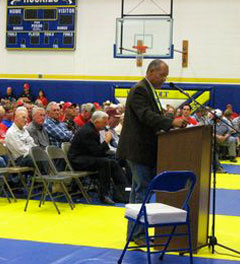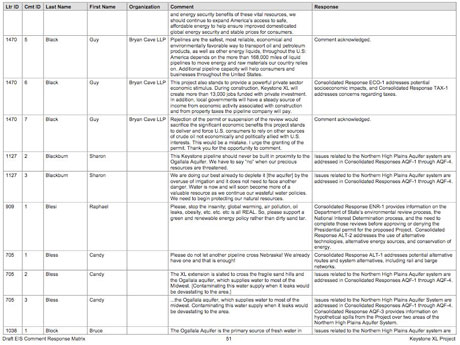Five weeks ago, Cindy Myers stood in a high school gymnasium before a crowd of 1,000 and said, “These words could be some of the most important of my life.”
Myers was speaking at the Keystone XL oil pipeline hearing in Atkinson, Neb., but her statement could have applied to any of the thousands of people who attended hearings in five other states. Many took a day off work to get in line early; others drove for hours to reach the meetings or spent weeks polishing their testimony. They spoke with passion about jobs and energy security, their fears of water contamination and the risk of an oil spill.
But do their opinions really matter? Will any of their comments reach the State Department officials who will decide whether to approve the 1,700-mile pipeline through the nation's heartland?
To try to answer those questions, InsideClimate News asked the State Department how the public comments are being processed and who is responsible for reading them.
After two weeks of e-mail exchanges and phone calls, however, the two agency spokeswomen we dealt with couldn't explain how or when the comments will be processed, or whether any of the actual decision-makers are obligated to review them. The spokeswomen said only that all agency staff working on the pipeline review will “have access to the comments.” When we asked for the names and job titles of those who might be expected to read the comments, we were told that information was not available.
Susan Luebbe, a Nebraska rancher who traveled at her own expense to speak at the final public hearing in Washington, D.C., said it was “depressing” to think that her comments may never reach decision-makers.
“So many people put a lot of effort into [the hearings] and followed along with the rules,” she said. “It would look really bad on [the agency's] part not to follow through on their word.”
The problem, it turns out, is that this last round of public testimony on the Keystone XL isn't protected by the National Environmental Policy Act (NEPA), a decades-old law that requires the State Department to solicit and respond to public comments about federal projects that could have a significant impact on the environment.
NEPA rules kicked in when a similar round of Keystone XL hearings was held in 2010. Those public comments were published, each with an agency response, in a 1,000-page appendix included in the final Environmental Impact Statement (EIS) that was released in August.
But the recent hearings were conducted during the ongoing “national interest” phase of the decision-making process, when the State Department determines whether the project's benefits outweigh its risks to the nation. This phase is governed not by NEPA, but by a three-page executive order signed in 2004 by President George W. Bush, which legal experts say gives the agency almost total discretion in handling public comments. Only two sentences mention public comments.
“There's no real formal public comment process that's explained or laid out,” said Jim Murphy, a senior attorney with the National Wildlife Federation. Unlike NEPA, which has extensive regulations and a long history of case law, “here [the agency] can kind of go into a black hole if that's what they want to do.”
Damon Moglen, director of climate and energy programs for the environmental group Friends of the Earth, said that in April a group of environmental organizations asked the State Department to hold a second round of hearings so the public could weigh in on a revised version of the agency's first draft EIS.
The State Department agreed to accept written comments. But the request for NEPA-regulated public hearings “was flatly denied,” Moglen said.
Cardno Entrix Is Involved in the Process
Despite the lack of NEPA regulation for the recent hearings, an agency spokeswoman said the agency would “make sure all the comments are taken into consideration in the decision.”
Three teams of State Department employees presided over the recent hearings, she said. Each was led by a senior official, usually a Foreign Service officer. The leader of the team that handled the Texas and Oklahoma hearings was a specialist on eastern European policy who has been with the agency for more than 20 years, the spokeswoman said.
Transcripts from the hearings, along with any written comments that were submitted, are being organized into a reader-friendly format, although the spokeswomen could not say when that process will be completed. Agency staff members are supervising the work with help from Cardno Entrix, the consulting firm that prepared the Environmental Impact Statement and helped organize the hearings.
The State Department has been criticized for hiring Cardno Entrix, because the firm counts TransCanada—the Alberta-based company that wants to build the pipeline—as a “major client,” and TransCanada paid for the environmental assessment that Cardno Entrix did under the auspices of the government. Last week, 14 members of Congress called for an investigation into possible conflicts of interest in the pipeline review, including Cardno Entrix's role in the process.
Cardno Entrix's involvement in tabulating the public comments is of particular concern to Kate Colarulli, associate campaign director for the Sierra Club's Beyond Oil campaign.
From April through June, her organization worked with seven other anti-pipeline groups to collect 269,000 written comments from their members. They submitted them electronically to a Cardno Entrix email address set up for that purpose.
But in July, when the Sierra Club checked the website that Carno Entrix maintains for the State Department, Colarulli said her office found that the company's count came up short by 94,000 comments. About 25,000 of the missing comments were written by Sierra Club members, she said.
“So we reached out to [State Department official] Alex Yuan, just saying there's a discrepancy, this is pretty weird,” Colarulli said. “Mr. Yuan was pretty concerned.”
Yuan told the Sierra Club to load the missing comments onto CDs and mail them to the State Department, Colarulli said. Two days later, Yuan “wrote us back and said never mind … we're not willing to take these comments.”
Colarulli said the agency still hasn't explained its actions. “At this point we've given up on thinking the State Department is going to fix this problem,” she said. State Department officials had a chance to solve the problem and they “chose not to. So I think that raises concerns about what role the [agency] is playing.”
The State Department did not respond to questions about the missing comments or a request to interview Mr. Yuan. Cardno Entrix referred questions to the State Department.
The agency's final decision on whether the Keystone XL should be built had been expected before the end of the year, but a government official recently indicated it might be delayed until early 2012. If approved, the pipeline would pump up to 830,000 barrels of tar sands crude oil per day from Alberta to the Gulf Coast.
How Previous Public Comments Have Been Assembled
A State Department spokeswoman said comments from the latest round of public hearings could be organized into a spreadsheet format similar to the one below, which was used for comments filed under NEPA rules. It's a page from Appendix A of the final Environmental Impact Statement, which lists written and hearing comments that citizens provided on the draft EIS and written comments on the supplemental draft EIS.
From left to right, the columns pictured in the above matrix are:
Ltr ID: every letter, email or individual's hearing testimony received a Letter ID.
Cmt ID: stands for “comment ID,” used to identify specific issues or topics. A letter might be divided into multiple comments.
Last name, First name, Organization: used to identify the individual who made the comment.
Comment: text from a written comment or a transcript of spoken hearing testimony.
Response: the State Department's response to each comment, based on information found in the final EIS. The responses are broken down by the categories listed in Appendix A, Part I.
Our most important fundraising appeal of the year
December is the most critical time of year for Truthout, because our nonprofit news is funded almost entirely by individual donations from readers like you. So before you navigate away, we ask that you take just a second to support Truthout with a tax-deductible donation.
This year is a little different. We are up against a far-reaching, wide-scale attack on press freedom coming from the Trump administration. 2025 was a year of frightening censorship, news industry corporate consolidation, and worsening financial conditions for progressive nonprofits across the board.
We can only resist Trump’s agenda by cultivating a strong base of support. The right-wing mediasphere is funded comfortably by billionaire owners and venture capitalist philanthropists. At Truthout, we have you.
We’ve set an ambitious target for our year-end campaign — a goal of $250,000 to keep up our fight against authoritarianism in 2026. Please take a meaningful action in this fight: make a one-time or monthly donation to Truthout before December 31. If you have the means, please dig deep.

